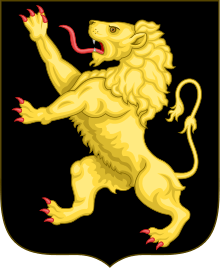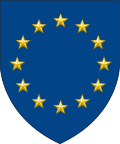Belgian Armed Forces
The Belgian Defense Forces (Dutch: Defensie; French: La Défense)[2][3] is the national military of Belgium. The King of the Belgians is the commander-in-chief of the Armed Forces. The Belgian Armed Forces was established after Belgium became independent in October 1830. Since that time Belgian armed forces have fought in World War I, World War II, the Cold War (Korean War and army of occupation of the Federal Republic of Germany), Kosovo, Somalia and Afghanistan. The Paracommando Brigade intervened several times in Central-Africa, for maintaining public order and evacuation of Belgian citizens. The Armed Forces comprise four branches: the Land Component, the Air Component, the Marine Component and the Medical Component.
| Belgian Armed Forces | |
|---|---|
| French: La Défense belge Dutch: Belgische Defensie German: Belgische Streitkräfte | |
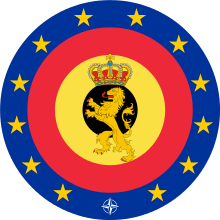 Emblem of the Belgian Armed Forces | |
| Service branches | |
| Leadership | |
| King | Philippe |
| Prime Minister | Sophie Wilmès |
| Minister of Defence | Philippe Goffin |
| Chief of Defence | Admiral Michel Hofman |
| Manpower | |
| Conscription | No |
| Active personnel | 25,000 |
| Reserve personnel | 3,300 (2019) |
| Expenditures | |
| Budget | €4.303 billion ($4.921 billion) (2019)[1] |
| Percent of GDP | 0.93% (2019)[1] |
| Related articles | |
| Ranks | Belgian military ranks |
History
Establishment
When Belgium broke away from the Netherlands in 1830 it was initially expected that a neutral buffer state, with its borders guaranteed by France, Britain and Prussia, could avoid the need for an expensive permanent military force, relying instead on the part-time militia of the existing Garde Civique (Civil Guard). The need for a regular army was however soon acknowledged. The basis for recruitment was one of selective conscription under which exemptions could be purchased by obtaining substitutes.[4] In practice this meant that only about a quarter of each year's eligible intake actually served, with the burden falling on the poorer classes.
Early history
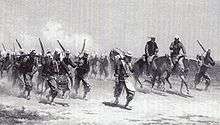
As part of the national policy of even-handed neutrality, the 19th century Belgian Army was deployed as an essentially defensive force in fortifications facing the Dutch, German and French borders. Mobilisation plans simply required reservists to report to their depots, without arrangements being made in advance for deployment in a particular direction or against a particular enemy. Recruitment difficulties caused the army to remain below its intended strength of 20,000 men, although new legislation in 1868 tightened the basis for conscription. The Franco-Prussian War of 1870 required full mobilisation for nearly a year, a process which showed up serious training and structural weaknesses. The presence of Belgian forces in strength along the country's borders, supported by intelligence provided by the Belgian civil security service,[5] did however ensure that the combat at no time spilled over into Belgian territory.[6]
As late as the 1890s the Belgian Army still retained a system of selective service, at a time when most European states were moving to a principle of universal obligation, according to the Prussian model. In Belgium conscripts were selected through the drawing of ballots, but individuals could escape service by paying for substitutes.[7] This system favored the well-off and had been discarded elsewhere as inefficient and unpatriotic. For those conscripted the terms of service required eight years in the regular army (of which part might be spent on "unlimited leave"), followed by five years as a reservist. Various categories of volunteer enjoyed such privileges as being able to specify their branch of service, bounties and higher pay.[8]
The Papal Army based in Rome included from 1860 a battalion-sized unit known as the Tirailleurs Franco-Belges (Franco-Belgian Sharpshooters). Recruited amongst volunteers from both countries, this became the Pontifical Zouaves in 1861 and fought as an allied force on the French side in 1871 during the Franco-Prussian War.[9]
In 1864 a Corps Expeditionnaire Belge (Belgian Expeditionary Corps) was raised for service in Mexico. Originally intended to serve as the Guard of the Belgian-born Empress Charlotte this 1,500 strong force was largely drawn from volunteers seconded from the Belgian Army. Known popularly as the Belgian Legion, it saw active service in Mexico as part of the Imperial forces, before returning to Belgium for disbandment in March 1867.[10]
From 1885 the Force Publique was established as the military garrison and police force in the Belgian Congo, then under the direct rule of King Leopold II. Initially led by a variety of European mercenaries, this colonial force was subsequently officered by Belgian regulars after 1908.
From December 1904 a small detachment of Belgian troops was permanently based in China as the "Guard of the Belgian Legation in Peking".[11]
Reforms undertaken in the early years of the 20th century included the abolition in 1909 of the system of drawing lots for the selection of the annual intake of conscripts. In 1913, compulsory and universal military service for men was established in Belgium. While this enabled actual peacetime strength to be increased to 33,000 men (increased to 120,500 on mobilisation), this was only sufficient to provide a basis for the creation of seven under-strength divisions (one of cavalry) plus artillery and fortress troops. The Belgian military was also affected by political and popular reliance on the supposedly certain protection of the country's internationally guaranteed neutrality. In the words of the historian Barbara W. Tuchman "the army was considered superfluous and slightly absurd".[12] Training and discipline were slack, equipment inadequate and even field uniforms were old fashioned and impractical.
Although improvements in the Belgian Army had been uneven during the 19th and early 20th centuries, one area of successful reform had been that of increasing the professionalism of the officer corps. The Royal Military Academy had been established in 1834, to be followed by the Ecole d'Application for technical training, and the Ecole de Guerre for staff training in 1868. The Belgian Army pioneered the practice of training a corps of finance, personnel and general administration specialist officers instead of leaving such functions to civil servants without military experience or inadequately prepared line officers. There was however a serious shortage of trained officers in the rapidly expanding army of 1913.[13]
Army in 1914
On the eve of World War I, the Belgian Army comprised 19 infantry regiments (line, Chasseurs à pied, Grenadier and Carabinier), 10 cavalry (Guides, Lancers and Chasseurs à cheval) and 8 artillery (mounted, field and fortress). Support forces included engineers, gendarmerie, fortress troops, train and civil guards. The seven divisions of the Field Army were intended to provide a mobile force while the 65,000 fortress troops provided garrisons for the substantial forts constructed around Antwerp, Liège and Namur. These fortifications had been built in several stages beginning in 1859, though a number were still incompleted in 1914. While well-designed and built by 19th century standards, these fixed defences with their sunken artillery turrets had been rendered obsolete by recent advances in heavy siege artillery howitzers.[14]
World War I
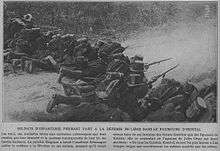
At the start of World War I in August 1914, the Belgian armed forces were being restructured, due to this measure and the rapid occupation of Belgium only 20% of men were mobilised and incorporated into the armed forces. Ultimately, 350,000 men were incorporated into the Belgian armed forces, although one third of these did not participate directly in combat.
Invaded by surprise by the Imperial German Army, which was approximately 600,000 men strong, the small, ill-equipped, 117,000-strong Belgian army succeeded, for ten days, in holding the German army in front of Liège in 1914. They fought between the emplaced forts in the area and with their support.[15] This strategy was based on the Napoleonic concept of fighting the advance force and preventing a portion of the enemy forces joining the main body. At the time, the authorities and the public celebrated a determined Belgian resistance that the Germans did not expect.
For four years, under the command of King Albert I, the Belgian army guarded the important sector of the Allied left wing between Nieuwpoort, on the coast, and Ypres with the help of the forces of the Entente but did not participate in any of the major Allied offensives, which were deemed unnecessarily expensive in terms of cost and manpower by the King of the Belgians.
In 1916, a body of Belgian armoured cars were moved from the IJzer front to help the Russian Empire. The force found itself alongside an identical body sent by the British on the Eastern Front.[16]
In Africa a company-sized unit of Belgian colonial troops participated in the occupation of the German colony of Togoland, The Force Publique subsequently played a major role in the East African Campaign against German forces in German East Africa, providing over 12,000 askaris under Belgian officers for the Allied offensive of February 1916.[17] The most significant Belgian action was the capture of Tabora in September 1916, by a force under the command of General Charles Tombeur.
In Belgium, after four years of war, as of 26 May 1918, the army had 166,000 men of which 141,974 were combatants, forming twelve infantry divisions and one cavalry division. It had 129 aircraft and 952 guns of all calibres. From September, the Belgian army was involved in the Allied offensive until the final victory of 11 November 1918.
Between the Wars
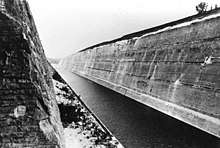
After the Armistice with Germany of 1918, the Belgian government sought to retain the strategy of 1914. Little effort was made to acquire tanks and aircraft for the Belgian armed forces, while instead the Government strengthened the fortifications of Liege and Antwerp. This was despite the fact that during World War I the forts had proved ineffective despite strong support from artillery and infantry. Until 1936, Belgium remained allied to France and the United Kingdom.
The Belgian Army underwent a series of reductions from 12 divisions in 1923 to only four after 1926. The rank and file consisted almost entirely of conscripts serving full-time for only 13 months, before entering the reserves.[18]
World War II
On 1 September 1939, when the Wehrmacht invaded Poland, King Leopold III of Belgium ordered a general mobilisation, in which 600,000 Belgians were mobilised. Despite warnings from the French and British governments, the King refused an alliance. Belgium was invaded, defeated, and occupied in an 18 Days' Campaign after 10 May 1940. Later, 163 Belgian troops were rescued during the Dunkirk evacuation, and Belgium's new navy, the Corps de Marine, only reformed in 1939, also participated.
After the defeat in 1940, significant numbers of Belgian soldiers and civilians escaped to Britain to join the Belgian forces in exile.[19] The Belgian government, under Hubert Pierlot, evacuated to London where it remained until the liberation in 1944.
Belgian soldiers formed the 1st Belgian Infantry Brigade (which also included an artillery battery of soldiers from Luxembourg) more often known as the Brigade Piron after its commanding officer, Jean-Baptiste Piron. The Brigade Piron was involved in the Normandy Invasion and the battles in France and the Netherlands until liberation.[20]
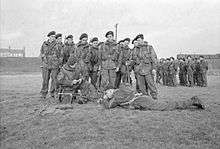
Belgians also served in British special forces units during the war, forming a troop of No.10 Commando which was involved in the Italian Campaign and Landings on Walcheren.[21] The British 5th Special Air Service (SAS) was entirely made up of Belgians.[22]
Two Belgian fighter units, the 349th and 350th Squadrons, were formed in the Royal Air Force, with over 400 pilots. The 350th Squadron alone claimed over 50 "kills" between its formation in November 1941 and the end of the war.[23]
Two corvettes and a group of minesweepers were also operated by the Belgians during the Battle of the Atlantic, numbering some 350 men by 1943.[24] Most military Belgian vessels of the Belgian navy were interned in Spain, except for the patrol craft P16, which managed to escape to the United Kingdom, where it became HMS Kernot.[25]
The Force Publique also participated in the East African Campaign and were instrumental to forcing the Italian surrender in Abyssinia.
| Belgium in World War II | ||
| Strength of primary military organizations | ||
| Military Organization | Period | Total personnel over time |
| 1940 Army | May - June 1940 | 600,000 - 650,000 |
| Free Belgian Forces | 1940–1944 | ca. 8,000 |
| Belgian Army 1944–1945 | June 1944 – May 1945 | ca. 100,000 |
| SS volunteers | April 1941 – May 1945 | ca. 15,000 |
| SS figures from Kenneth Estes A European Anabasis. | ||
Post 1945
The harsh lessons of World War II made collective security a priority for Belgian foreign policy. In March 1948 Belgium signed the Treaty of Brussels, and then joined NATO in 1948. However the integration of the armed forces into NATO did not begin until after the Korean War, to which Belgium (in co-operation with Luxembourg) sent a detachment known as the Belgian United Nations Command. Later Belgium contributed a corps to NATO's Northern Army Group. Defence expenditure grew along with the force size. In 1948 the army was 75,000 strong which grew to 150,000 by 1952.[26] A major defence review in 1952 set a target of three active and two reserve divisions, a 400-aircraft air force and a fifteen-ship navy. Forty anti-aircraft defence battalions were created, linked with radar and a centralised command-and-control system.
As a safeguard against Belgium being invaded again, two major bases, Kitona and Kamina, were established in the Belgian Congo. They were almost viewed as a 'national redoubt,' permitting the survival and rebuilding of forces if Belgium were again invaded.[27]
Following a change in government in 1954 conscript service was reduced to 18 months. The Belgian Army gained nuclear capability in the 1950s with Honest John missiles initially and then with nuclear-capable tube artillery. It also adopted the U.S. Pentomic organisation, but then switched to a triangular division structure by the early 1960s. Just after independence in the Congo, a Metropolitan Command (Cometro) was active to control the Belgian forces there.[28]
Current status
Since 2002, the three independent armed forces have been merged into one unified structure and organised with four components. They are structured as follows:
- Land Component, previously known as the Land Force (Force Terrestre / Landmacht / Heer);
- Air Component, previously known as the Air Force (Force Aérienne / Luchtmacht / Luftmacht);
- Marine Component, previously known as the Naval Force (Force Navale / Zeemacht / Seemacht),
- Medical Component, previously known as the Medical Service (Service Médicale / Medische dienst / Sanitätsdienst).
The operational commands of the components (COMOPSLAND, COMOPSAIR, COMOPSMAR and COMOPSMED) are directly subordinate to the Chief of Defence (CHOD).
As a result of the increased threat of terrorism which became apparent in January 2015, the Belgian Armed Forces were committed in Operation Homeland, to assist the police with securing high-profile targets in the major cities. After the attacks of 22 March 2016, this military protection was expanded to include soft targets in the public space, increasing the commitment of troops to between 1250 and 1800 (Operation Vigilant Guardian).[29]
The Belgian Land, Air, and Medical Components all use the same military ranks. The Naval Component's ranks are unique in the Belgian Armed Forces.
Land Component
The Belgian Land Component is the ground arm of the Belgian Armed Forces. The Land Component Commander is Major-General Pierre Gérard.(since October 18, 2019). The Land Component consists of one staff (COMOPSLAND), one motorized brigade, one special operations regiment supported by an artillery battalion, two engineer battalions and a reconnaissance (ISTAR) battalion. It is also supported by three logistical units, three telecommunication units, four training camps and a center for the training of ground troops. The land component has some 10,000 troops (as of 2019) and trained for foreign operations in a multinational environment.
Air Component
%2C_taxiing%2C_Radom_AirShow_2005%2C_Poland.jpg)
The Belgian Air Component is the air arm of the Belgian Armed Forces. The history of the Belgian Air Force began in 1910 when the Minister of War, General Hellebout, decided after his first flight to acquire aeroplanes. On 5 May 1911 a Farman type 1910 was delivered, followed by a second on 24 May and two other in August of the same year. The air component commander is Major-General aviator Frederik Vansina (as of December 5, 2014). The air component consists of two fighter aircraft wing, the second tactical wing in Florennes, operating the F-16 Fighting Falcon and a unit (80 UAV squadron) flying the B-Hunter reconnaissance UAV, the 10 tactical wing in Kleine Brogel, operating the F-16 Fighting Falcon, the 15 air transport wing in Melsbroek operating 10 Lockheed C-130 Hercules transport aircraft as well as a small fleet of troop transport and VIP aircraft, a multi-aircraft wing and the first wing in Beauvechain operating training aircraft and helicopters (A-109 and NH-90 helicopters). Aside from these flying units, the air component is supported by several support units, such as an air traffic control center, an air defense center (Control and Reporting Center), a meteorological wing and an aviation safety directorate.[30]
Marine Component

The Belgian Marine Component is the naval arm of the Belgian Armed Forces. It currently has 1,700 personnel and 12 vessels. The Naval Component Commander is Division Admiral Wim Robberecht, since September 20, 2016. Current vessels are:
Frigates:
Minesweepers:
Support Vessels:
Patrol Boats:
- BNS P901 CASTOR Patrol ship
- BNS P902 POLLUX Patrol ship
Auxiliary Vessels:
- BNS A958 Zenobe Gramme (training ship)
- BNS A992 Alpa (royal yacht)
Medical Component
The Medical Component is commanded by a Major General and is composed of 1700 active personnel. Providing medical support to all personnel of the Belgium Armed forces, it consists of a Military Hospital and 2 Medical Battalions as well as a Medical Supply Unit.
Intelligence
A Belgian military intelligence service was founded on 1 April 1915. The Belgian General Information and Security Service, known as ADIV (Dutch) or SGRS (French) and part of the organisational chart of Belgian Defence as ACOS-IS (Assistant Chief of Staff Intelligence and Security) provides security intelligence for the Armed Forces as well as strategic intelligence for the Belgian government. Its focus is on counterespionage.[31]
The Jagers te Paard ( ISTAR ) Battalion also conducts military intelligence with a tactical goal of preparing and supporting operations abroad.[32]
Famous soldiers and officers
- General Alphonse Jacques de Dixmude
- General Victor van Strydonck de Burkel
- General Émile Dossin de Saint-Georges
- Lieutenant General Jean-Baptiste Piron
- General Léon de Witte de Haelen
- Lieutenant-General Félix Wielemans
- Jean de Selys Longchamps
- Pierre Emmanuel Félix Chazal
- Émile Francqui
Belgian Royal family in the Belgian Armed Forces
| Member | Land Component | Air Component | Marine Component | Medical Comp. | |
|---|---|---|---|---|---|
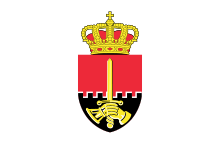 |
 |
 |
|||
| The King | General | General | Admiral | ||
| The Archduchess of Austria-Este | Colonel (2003) | ||||
| Prince Laurent | Captain (2004) Fr : Capitaine de Vaisseau Nl : Kapitein-ter-zee | ||||
| Prince Amedeo | Second Lieutenant (2007) | ||||
| Prince Joachim | Ensign 2nd Class (2011) | ||||
See also
- List of Belgian military decorations
- Belgian United Nations Command – the Belgian detachment sent to the Korean War of 1950–53
Notes
- "Defence Expenditure of NATO Countries (2012-2019)" (PDF). NATO Public Diplomacy Division. 25 June 2019. Retrieved 31 August 2019.
- "La Défense" (in French). Retrieved 25 March 2016.
- "Defensie" (in Dutch). Retrieved 25 March 2016.
- John Keegan, page 55 "World Armies", ISBN 0 333 17236 1
- Lasoen, Kenneth (2015). "Les secrets du département de la guerre. Militaire inlichtingen 1830-1914". In Cools, Marc e.a. (ed.). 1915-2015: Het verhaal van de Belgische militaire inlichtingen- en veiligheidsdienst. Antwerp: Maklu. pp. 100–102.
- Barbara W. Tuchman, page 126 "The Guns of August", Constable and Co Ltd 1962
- Fedor von Koppen, page 71 "The Armies of Europe", ISBN 978-1-78331-175-0
- British War Office, pages 2-3 "Handbook of the Belgian Army", ISBN 978-1-78331-094-4
- Guy Derie, page 130 "Les Soldats de Leopold Ier et Leopold II",D 1986/0197/03 Bruxelles
- Guy Derie, page 124 "Les Soldats de Leopold Ier et Leopold II", D 1986/0197/03 Bruxelles
- Guy Derie, page 134 "Les Soldats de Leopold Ier et Leopold II", D 1986/0197/03 Bruxelles
- Barbara W. Tuchman, page 127 "The Guns of August", Constable and Co Ltd 1962
- R. Pawly & P. Lierneux, page 4 "The Belgian Army in World War I, ISBN 978 1 84603 448 0
- Courcelle, R. Pawly & P. Lierneux ; illustrated by P. (2009). The Belgian Army in World War I. Oxford: Osprey. pp. 4–6. ISBN 9781846038938.
- Carl Pepin. "the invasion of Belgium". First World War (1902–1932). Retrieved 26 April 2014.
- (in English) "Belgian Armored Cars in Russia". Retrieved 17 February 2011.
- Peter Abbott, pages 19-21 "Armies in East Africa 1914-18", ISBN 1 84176 489 2
- John Keegan, page 56 "World Armies", ISBN 0 333 17236 1
- "Units of the Belgian armed forces in the United Kingdom 1940–1945". be4046.eu. Retrieved 27 February 2013.
- "History of the Piron Brigade". www.brigade-piron.be. Archived from the original on 6 February 2007. Retrieved 15 December 2012.
- "The Belgian Commando Troops, 1942–1945". be4046.eu. Retrieved 4 March 2013.
- "The Belgian SAS in WWII – A Very Short History". belgiansas.us. Archived from the original on 16 August 2014. Retrieved 4 March 2013.
- Ready, J. Lee (1985). Forgotten Allies: The Military Contribution of the Colonies, Exiled Governments, and Lesser Powers to the Allied Victory in World War II. Jefferson, N.C. u.a.: McFarland. p. 254. ISBN 978-0-89950-129-1.
- Thomas, text by Nigel (1991). Foreign volunteers of the allied forces : 1939–45. London: Osprey. p. 17. ISBN 978-1-85532-136-6.
- "HMS Kernot ex P16". Marine Belge. Archived from the original on 23 August 2011. Retrieved 22 March 2013.
- Isby and Kamps 1985, p.59
- David Isby and Charles Kamps Jr, 'Armies of NATO's Central Front,' Jane's Publishing Company, 1985, p.59. See also J. Temmerman, 'Le Congo: Reduit National Belge,' in Recueil d'etudes <<Congo 1955-1960>>, Academie royale des Sciences d'Outre-Mer (Bruxelles) pp.413–422 (1992)
- For Cometro and the metropolitain forces in the Congo at independence, see Louis-François Vanderstraeten, De la Force publique à l'Armee nationale congolaise : histoire d'une mutinerie : juillet 1960, Bruxelles : Académie Royale de Belgique ; Paris-Gembloux : Duculot, ©1985. ISBN 2-8031-0050-9, 88–96.
- Lasoen, Kenneth (2018). "War of Nerves. The Domestic Terror Threat and the Belgian Army". Studies in Conflict & Terrorism. 42: 1–19. doi:10.1080/1057610X.2018.1431270.
- "Luchtcomponent" (in Dutch). 23 September 2018.
- Lasoen, Kenneth (2017). "For Belgian Eyes Only. Intelligence Cooperation in Belgium". International Journal of Intelligence and CounterIntelligence. 40 (3): 464. doi:10.1080/08850607.2017.1297110. hdl:1854/LU-8512001.
- Standing Review Committee of the Intelligence Services, Committee I (2014). Activiteitenverslag 2013 - Report d'activités 2013 (PDF). Antwerp: Intersentia. p. 13.
References
![]()
External links
| Wikimedia Commons has media related to Military of Belgium. |
- Official website (in French and Dutch)
- Belgian army rank insignia
- Simoens, Tom: Belgian Soldiers, in: 1914-1918-online. International Encyclopedia of the First World War.
